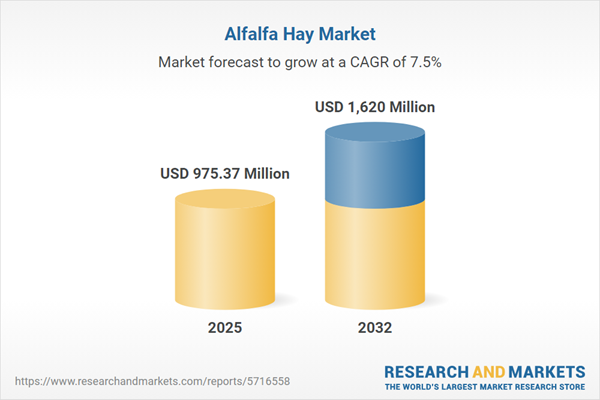Speak directly to the analyst to clarify any post sales queries you may have.
The alfalfa hay market is experiencing dynamic changes as businesses respond to technological advancements, sustainability requirements, and evolving supply chains. Senior decision-makers face a landscape marked by fresh opportunities and operational complexities, underscoring the need for actionable insight and agile strategy within the alfalfa hay sector.
Market Snapshot: Alfalfa Hay Market Size and Growth Outlook
The alfalfa hay market rose from USD 908.01 million in 2024 to USD 975.37 million in 2025. Projected to grow at a CAGR of 7.54%, the market is anticipated to reach USD 1.62 billion by 2032. Demand from livestock nutrition, technology innovation, and shifting regulatory frameworks are key drivers for ongoing expansion.
Scope & Segmentation of the Alfalfa Hay Market
This report provides a thorough examination of the alfalfa hay market, exploring categories, delivery models, and market regions to equip stakeholders with deep visibility into growth drivers and emerging trends.
- Product Types: Both conventional and organic alfalfa hay, with increasing buyer focus on organic for its chemical-free credentials.
- Forms: Baled hay (including large round, large square, small square); cubes with high protein and standard choices; pellets in standard and high protein grades to meet feed flexibility.
- End Users: Producers across beef cattle, dairy herds seeking digestibility, and equine operations maintaining elevated quality parameters.
- Distribution Channels: Direct sales at the farm gate and feedlots; E-commerce via company websites and third-party platforms; Retail through agricultural retailers and specialty outlets, each adapting to buyer habits and logistical considerations.
- Regions Covered: Markets spanning the Americas (including North and Latin America), Europe, Middle East & Africa, and Asia-Pacific—encompassing key buyers and regions from the United States and Canada to China and Australia, each characterized by unique climatic, policy, and infrastructure influences.
- Leading Companies: Industry participants include Cargill, Archer Daniels Midland, Land O’Lakes, Scoular Company, Wilbur-Ellis, Nutrien, Nutreco, and J. R. Simplot Company, among others.
Key Takeaways for Senior Decision-Makers
- Precision agriculture and modern irrigation methods enable more reliable forage quality and enhance operational resource efficiency.
- Broad adoption of sustainability initiatives, such as regenerative practices, positions companies to align with regulations and the increasingly eco-conscious end customer.
- Expansion into value-added forms—including cubes and pellets—addresses the specialized feeding needs of premium dairy and equine clients.
- Digitalization throughout supply chain activities streamlines traceability, supports rapid response to market changes, and strengthens overall business continuity.
- Infrastructure differences, climate variability, and evolving policies are shaping both supply chain design and regional market entry decision-making.
Evaluating Tariff Impact and Competitive Landscape
The 2025 revision of U.S. tariff structures has shifted alfalfa hay trading patterns, as increased input and import costs prompt domestic purchasers to source regionally. This adds pressure on local producers to deliver both quality and volume. Export-focused businesses pivot to offering higher-value products and certifications to safeguard profitability. Additionally, cost increases on essential machinery and fertilizer highlight the importance of investments in efficiency-driven technologies and scalable business models to remain competitive over time.
Market Research Methodology & Data Sources
This analysis combines extensive secondary research from sector reports, academic sources, and regulatory documents with primary interviews involving agronomists, feed specialists, and logistics professionals. Rigorous data validation and scenario-based analysis ensure robust trend identification and dependable support for strategy development.
Why This Report Matters
- Enables executives to anticipate and adapt to rapid changes in the alfalfa hay market, including shifts in buyer expectations and policy developments.
- Delivers actionable intelligence that supports capital allocation, operational improvements, and sustainable competitive positioning in a complex supply environment.
Conclusion
This report offers senior leaders granular, up-to-date analysis on how technology, sustainability, and trade policies are influencing the alfalfa hay market. Its strategic insights help companies navigate challenges and realize new opportunities in a competitive global context.
Additional Product Information:
- Purchase of this report includes 1 year online access with quarterly updates.
- This report can be updated on request. Please contact our Customer Experience team using the Ask a Question widget on our website.
Table of Contents
3. Executive Summary
4. Market Overview
7. Cumulative Impact of Artificial Intelligence 2025
Companies Mentioned
The companies profiled in this Alfalfa Hay market report include:- Cargill, Incorporated
- Archer Daniels Midland Company
- Land O'Lakes, Inc.
- Scoular Company
- Wilbur-Ellis Company
- Nutrien Ltd.
- Nutreco N.V.
- J. R. Simplot Company
Table Information
| Report Attribute | Details |
|---|---|
| No. of Pages | 187 |
| Published | November 2025 |
| Forecast Period | 2025 - 2032 |
| Estimated Market Value ( USD | $ 975.37 Million |
| Forecasted Market Value ( USD | $ 1620 Million |
| Compound Annual Growth Rate | 7.5% |
| Regions Covered | Global |
| No. of Companies Mentioned | 9 |









